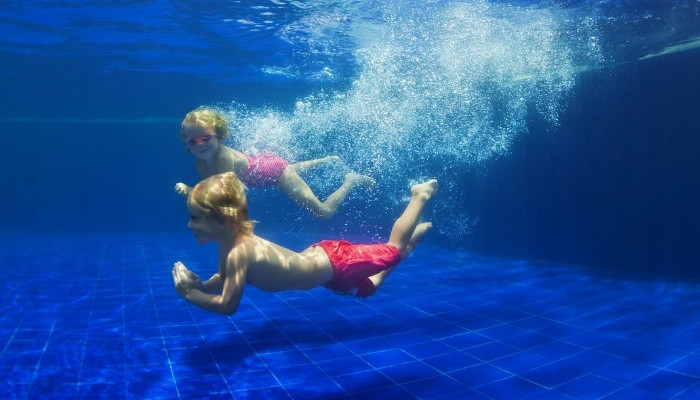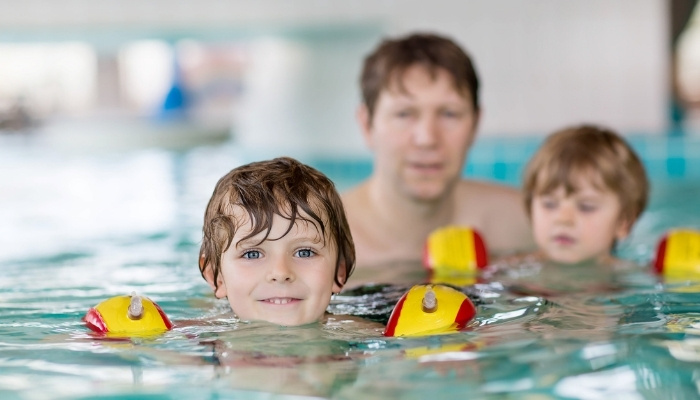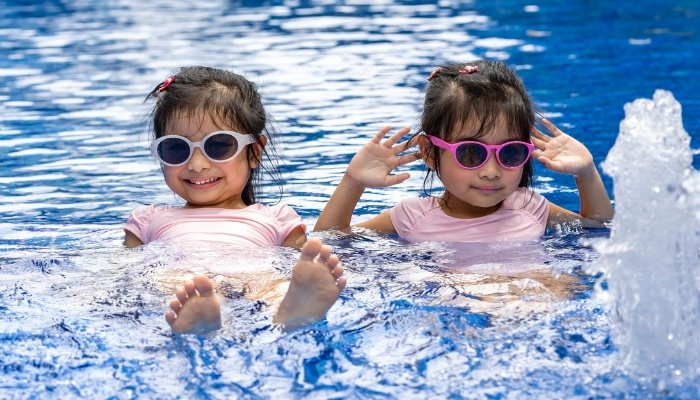As the summer season approaches and temperatures rise, you’re getting ready for a refreshing swimming adventure.
If you don’t know where to start or want to make sure that you’ve covered your bases, this comprehensive guide to swimming with twins was written for you.
1. Swimming Lessons
The first step in creating a safe swimming scenario for your twins is deciding whether to enroll them in swimming lessons. Determine your children’s overall risk by analyzing their age, medical status, and exposure to water.
Swimming lessons are recommended by the American Academy of Pediatrics for children ages 4 and up. Survival lessons are designed to introduce children to basic water safety starting at 1 year of age.
While these lessons can be costly, some parents consider them a worthwhile investment.
2. Consider Swimsuit Colors
When shopping for swimsuits, consider opting for bright, vibrant colors as an alternative to darks and neutrals. Doing so could save your children’s lives in the event of an emergency.
Drowning is not a noticeable, chaotic event in most cases. Statistics show that most child drownings are silent because they’re unsure of when and how to seek help.
Having a highly contrasting swimsuit not only allows you to easily identify where your child is but allows the lifeguard scanning the pool the same advantage.
Alive Solutions conducted an informal study showing swimsuit visibility in different bodies of water.
These studies revealed that bold colors, such as pink, yellow, orange, and lime green, had higher contrast against the water than their counterparts.
3. Prepare a Checklist
Preparing a checklist helps to anticipate your twins’ swimming needs before the actual packing process begins.
There are a few unavoidable items that you’ll need to bring such as pool towels, dry clothes for the ride home, a wet bag for the soaked swimsuits, lip balm with SPF, and sunscreen.
Based on the rules of where you’re swimming, you’ll likely need to pack snacks, drinks, age-appropriate flotation devices, and goggles.
If you’re planning to swim at the beach, you should consider additional items such as a beach umbrella, beach chairs, and a sand-resistant beach mat.
4. Pack in Advance
Every mother has been a flustered, frustrated mess in the hours before a holiday or trip. Double the children can mean double the disorder.
Avoid the morning mayhem by packing your checklist of items the night before your anticipated pool trip once the twins fall asleep.
Give yourself plenty of time to pack snacks, prepare cups, layout swimsuits, and set up a grab-and-go breakfast.
5. Plan Swim Times To Fit With Your Usual Daily Routine
If your children are in the infant or toddler years, they likely have a daily routine consisting of set meal and nap times.
Disruptions in the patterns that your twins are accustomed to could cause unrest in their behavior. For this reason, it’s best to plan your swimming day following their existing schedule.
This can be a challenge for parents of twins as you have two individual children of the same age who don’t always share correlating routines.
Determining the longest period between their sleep sessions will give you the most opportune time to schedule your swimming trip.
Meals can often be packed and taken on the go, but just remember to check the rules of your swimming environment for restrictions.
6. Review Safety Rules
Not all swimming environments are created equally. Reviewing your location’s safety rules will help you prepare for any situations that may arise and manage expectations.
These rules should outline whether a lifeguard will be on duty, whether snacks or drinks are allowed, what types of water toys or floatation devices are acceptable, and what skill level is needed to swim.
This information is typically available for viewing online, but you may need to call instead.
Also, review any personal safety rules with your children, such as no running beside the pool, they must wait after eating before going back in the water, etc.

7. Bring Another Adult if Possible
You’ve had your hands full from the moment they took their first breath. Having twins is not easy, and you may feel comfortable managing both children on your own.
However, having an additional pair of eyes, hands, and legs can be a valuable asset while taking your children swimming.
If both twins demand your attention, having a second adult present means you can delegate some of the heavy lifting.
Alternatively, if one twin gets into an emergency, having another adult by your side allows you the space and support to handle the situation calmly and wholeheartedly.
8. Wait For Swim Diapers Until You Arrive
You may be eager to get your children in their swim gear prior to arriving at your destination.
While the urge to avoid changing your children in public places is understandable, consider that swim diapers are designed to be nonabsorbent.
This means that if your child uses the bathroom on the car ride there, they’re likely to soak both their car seat and themselves.
9. Apply Sunscreen 15 Minutes Before Swimming
The American Academy of Dermatology advises applying sunscreen at least 15 minutes before swimming to allow for absorption.
They recommend an infant-safe sunscreen with an SPF of 30-50 for children 6 months or older and to opt for creams rather than sprays.
Check to ensure that your sunscreen has not expired and does not contain irritants for your babies’ skin such as parabens, phthalates, dyes, and fragrances.
10. Use Flotation Devices
It is vital to understand which flotation devices are appropriate for your children’s weight, their skill level, and the type of excursion.
For infants and toddlers unable to swim, check that their floatation devices can turn them upright in the water and keep their heads above the surface.
Additionally, the flotation device should have a strap between the legs to prevent movement and one across the chest or back to serve as a handle.
These devices should be tested on your children for proper fit and comfort in the water before any long excursion.
While these devices are designed to keep people afloat in the water, they can create a false sense of security in parents and children alike.
Making sure your child has the proper flotation device does not replace a watchful eye or appropriate water depth and condition; it only adds a layer of protection.

11. Stay Within An Arm’s Reach
It only takes 20 seconds for a child to drown, and it is unlike anything portrayed in the media. Drowning is often a silent event in which the child is incapable of reaching out for help.
Regardless of how old your children are or what flotation devices they’re using, being in the water with them could save their lives.
Relying on the on-duty lifeguard to serve as a babysitter is the biggest mistake a parent can make. Even if they happen to spot your child in the water, their response will likely be delayed by distance and crowding.
You should constantly be supervising your young children in the water, but staying within an arm’s reach could be the difference between a close call and the real deal.
12. Watch For Signs of Heat-Related Illness
Throughout the day you should be monitoring your twins for symptoms of heat-related illnesses. Understanding these symptoms will help you better assess when to get your little ones out of the heat.
- Mild heat illness symptoms can include muscle spasms, swelling hands, tiny red bumps on the skin, irritability, fatigue, and muscle weakness.
- Moderate heat illness symptoms can include sweating, pale skin, fatigue, nausea, rapid or weak pulse, and headaches.
- Severe heat illness symptoms can include convulsions, confusion, fainting, and irregular heartbeat.
If your children display any of these symptoms, immediately remove them from the heat, and begin to cool them down. Apply cool compresses, and allow them to sip on water or electrolyte drinks.
Call the pediatrician immediately if your child displays any moderate to severe symptoms.
13. Reapply Sunscreen Often
Applying sunscreen once will not offer your twins the protection needed for a day of play. Studies show that reapplication should take place every 30 minutes for maximum UV protection.
This is especially important in cases where the sunscreen is subject to external wear from activities such as swimming.
If you’ve accounted for food breaks, reapplying any time your children are out of the water eating will allow enough time for the sunscreen to absorb into the skin.
14. Make Sure Kids Take Frequent Breaks
It’s easy to exhaust an infant, toddler, or child with any outdoor activity.
Making sure your kids take frequent breaks is a way to check their physical condition, maintain their normal feeding routines, and judge when to leave based on their behavior.
Regardless if they are 6 months or 6 years old, every child needs a break from physical activity in the sun, or they will run themselves ragged.
Final Thoughts
Following this guide should make you feel confident in evaluating and preparing your family’s needs. The result should be a relaxing and enjoyable swimming experience.
Charley is a mother of three with a passion for raising good humans. With her children in tow, she studies English and has made a career creating content about motherhood. In her free time, she enjoys traveling within the states to kayak, camp, and hike.

